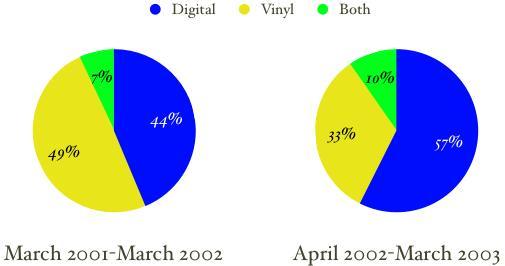| to a computer and an internet connection. After purchasing an MP3 online, you’re given a link to download the file. Currently, only Supreme Audio is selling MP3s online, but Palomino is working on a delivery system. Non-standard square dance music: Some callers, including me, like to find music that wasn’t produced specifically for square dancing but that can be used for patter calling. Last year at CALLERLAB, Clark Baker put together a panel on this, featuring Jerry Jestin, Ted Lazotte, and John Sybalsky. The tape from this session is fun, both for the music and the choreography. You can find non-standard music on CDs and MP3s. It requires some digging around and listening to lots of samples on the web. In addition to CDs and MP3s, you might also look at MIDI files. MIDI files are not sound files; they’re sequences of instructions for producing sound from | ||||||||||||
| By Kris Jensen On the March 2003 Hanhurst tape, 34 of the tunes were available as CD or MP3 only. If you’re only using 45 rpm vinyl, it’s time to start thinking about your digital future. There are three aspects: your music source (how you get your square dance music: vinyl, CD, MP3, or even MIDI), your music output (how you play your music at a dance) and any processing that you want to do, including transforming music from your source to your output medium. Sources Music released specifically for square dancing: Vinyl (45 rpm records): Most square dance music is still being released on | vinyl. However, the cost is high and the return is low, so producers are looking at alternatives. CDs: This is my favorite music source. I get uncompressed sound files, often in several different keys, and with alternative arrangements (for example, the same song can be released with and without a vocal background). CDs would be expensive if the producers were using commerical CD pressing plants. However, for square dancing, the quantities are small enough that producers seem to be using regular CD-R burners, thus keeping the cost low. MP3s: MP3 files are compressed sound files. Some information is lost during the compression, but in general, only sounds that are inaudible to humans are discarded. High quality MP3s are considered to be “near-CD” quality. MP3s are available only if you have acces | ||||||||||||
 | |||||||||||||
| I tried to include only “new” releases, but this does include newly released CDs that contain music that was formerly available on vinyl, but is now out-of-print. I tried to avoid “golden oldies” where both MP3 and vinyl are available. I counted tracks (distinct tunes). For example, a two-sided patter record counts as two tracks; a CD with one tune in multiple keys or with and without vocal backgrounds counts as one track. | |||||||||||||